Last week, CEO Alex Chriss unveiled PayPal’s new AI-led strategy in a First Look event that promised to “shock” the industry. But how do the products unveiled change PayPal’s plans and stack up against competitors?
Last Thursday, days after promising to “shock” the industry with a series of AI-based announcements, PayPal released a prerecorded First Look keynote that saw CEO Alex Chriss unveil a six-point strategy for the brand. The keynote, the first of its kind from Chriss since he took over from Dan Schulman on 27 September 2023, was designed to set out a vision for the company under its new CEO as he looks to return PayPal to strong growth. Largely focusing on optimisations to the company’s merchant and ecommerce offerings, the keynote focused on products that will initially launch in the US across 2024, with a view to expanding these internationally further ahead.
However, industry response to the announcements were muted and investors reacted negatively to the plans, with much of the subsequent press coverage focused on the disconnect between comments made by Chriss ahead of the keynote and the contents of the announcement itself. In the days since, PayPal has announced plans to layoff 2,500 employees, equivalent to 9% of its workforce.
In this report, we take a detailed look at the keynote, focusing on what was and wasn’t included in PayPal’s First Look strategy. We explore how AI is being used by the company and how its plans compare to other products offered by industry rivals.
PayPal’s First Look product announcements
In the keynote video, Chriss framed the product announcements as “the most impactful innovations [PayPal is] piloting and bringing to market this year”, adding that the company believed they would “change commerce as we know it”.
All the announcements were described as playing a role in the company’s “mission to revolutionise commerce, globally”, with Chriss saying that AI created the potential for businesses to use insights to gain more customers, while shoppers would “get deeply personalised experiences like never before”.
All six products therefore focused on tuning or adding to the ecommerce process in order to either improve sale rates for merchants, increase the desire for consumers to make purchases or both. Notably, however, not all of these are new. In some cases these are either enhancements to existing products or confirmation of products that had been previously announced but not yet launched.
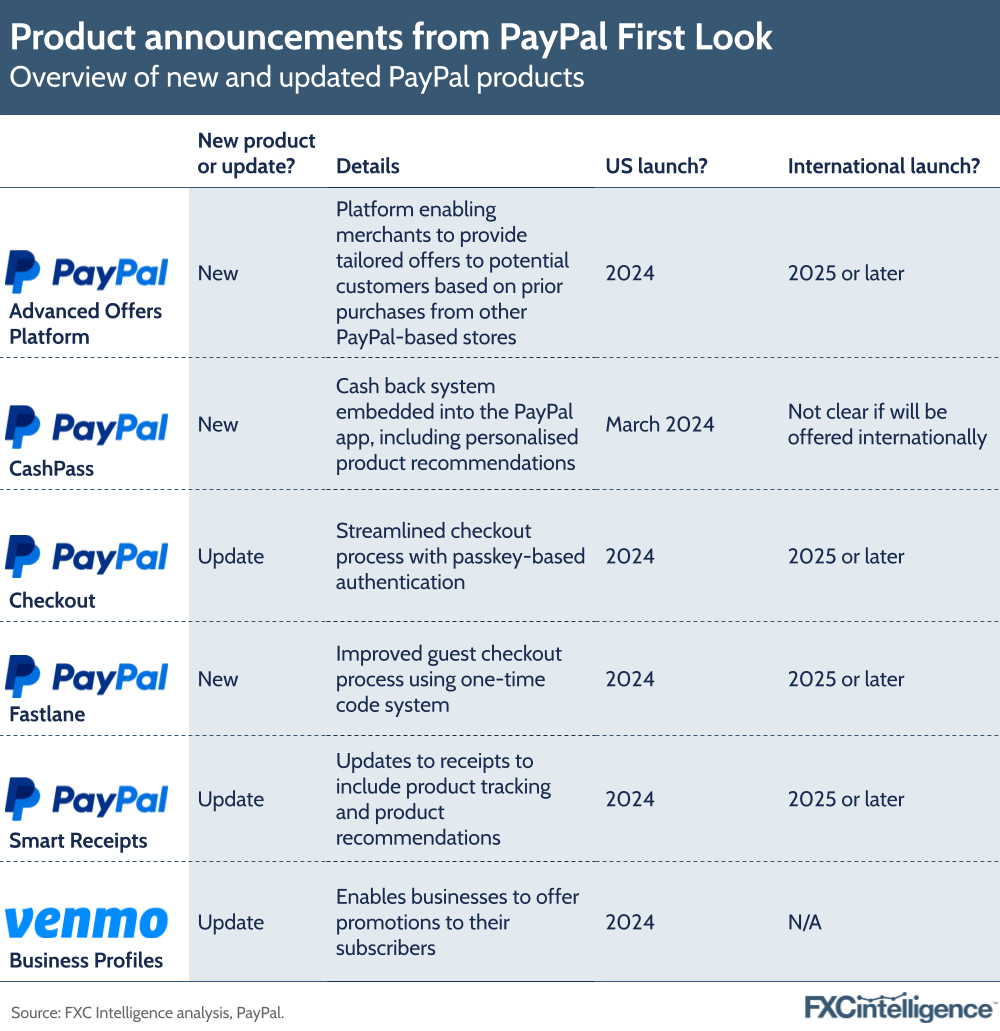
Checkout improvements
At the top of PayPal’s list of announcements is improvement to the speed of its checkout process by reducing lag and friction that can contribute to cart abandonment. Here the company says it has improved checkout through three elements:
- Streamlined the checkout process via a redesigned user interface.
- Faster authentication via the integrated passkeys, which enable customers on both Android and iOS to log in with their face or fingerprint.
- A reduction in latency by up to 50%, according to PayPal, which cites internal data collected across October 2023.
The end result is an updated process with fewer steps than the previous system via PayPal. Given that each step represents an opportunity for cart abandonment, this does therefore suggest that the new version will reduce this issue for merchants.
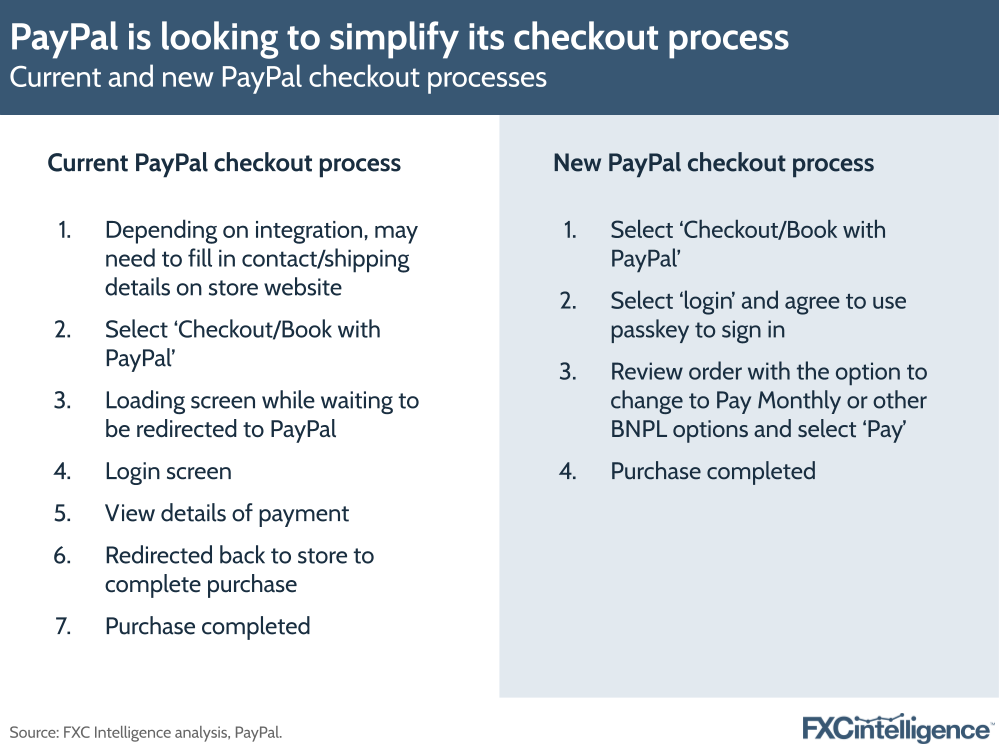
However, the new UI bears an increased resemblance to Shop Pay, Shopify’s rival service for merchants. Shopify claims to be the “highest converting accelerated checkout on the internet”, so it makes sense for PayPal to look to emulate its features.
Passkeys are also already available for customers on a number of rival payment platforms, including Shop Pay, and were first announced for PayPal on iOS in 2022 and Android in 2023. These details therefore raise questions about the revolutionary claims made by PayPal.
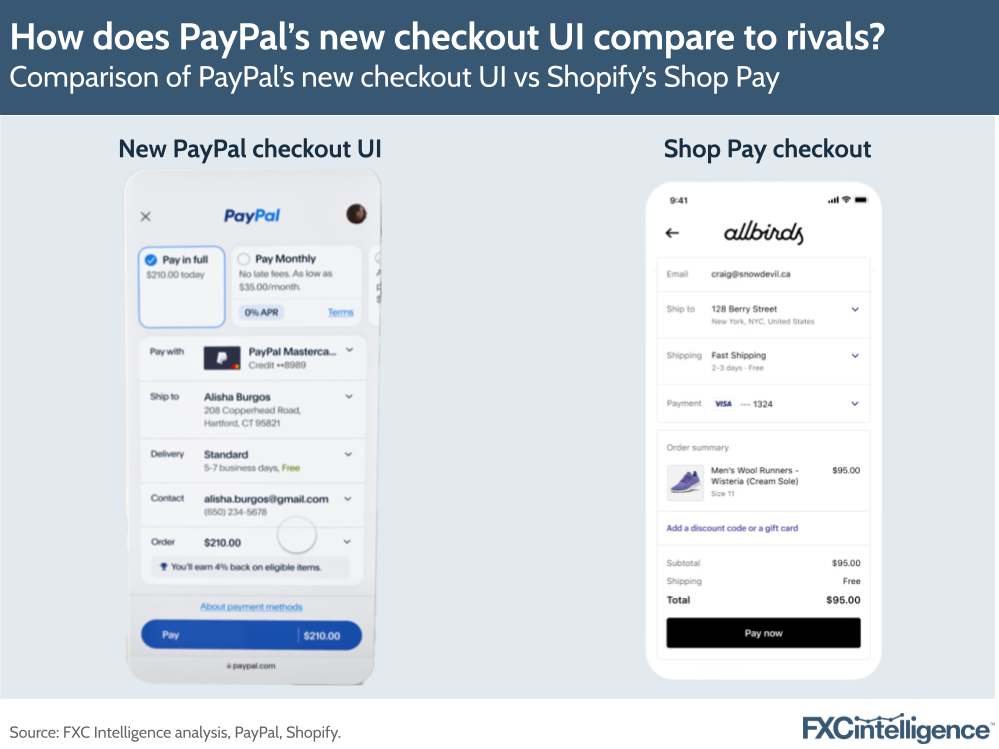
Fastlane by PayPal
An extension of its improvements to the checkout experience, Fastlane by PayPal is designed to improve the guest checkout process through the use of one-time codes.
Here, a customer enters their email address and if the company already has details for them, it will send a text message with a one-time code that when entered – a process that can be done automatically via most handsets – will automatically populate the checkout fields.
PayPal reports that early trials with its long-term partner BigCommerce have seen 70% of guests recognised via the process and have resulted in an average guest checkout speed improvement of “nearly 40%”.
This process does have clear potential to produce improvements for customers and merchants, giving it the potential to positively impact PayPal’s bottom line. However, a similar code-based process is already in use by Shop Pay, again reducing the revolutionary impact of this announcement.
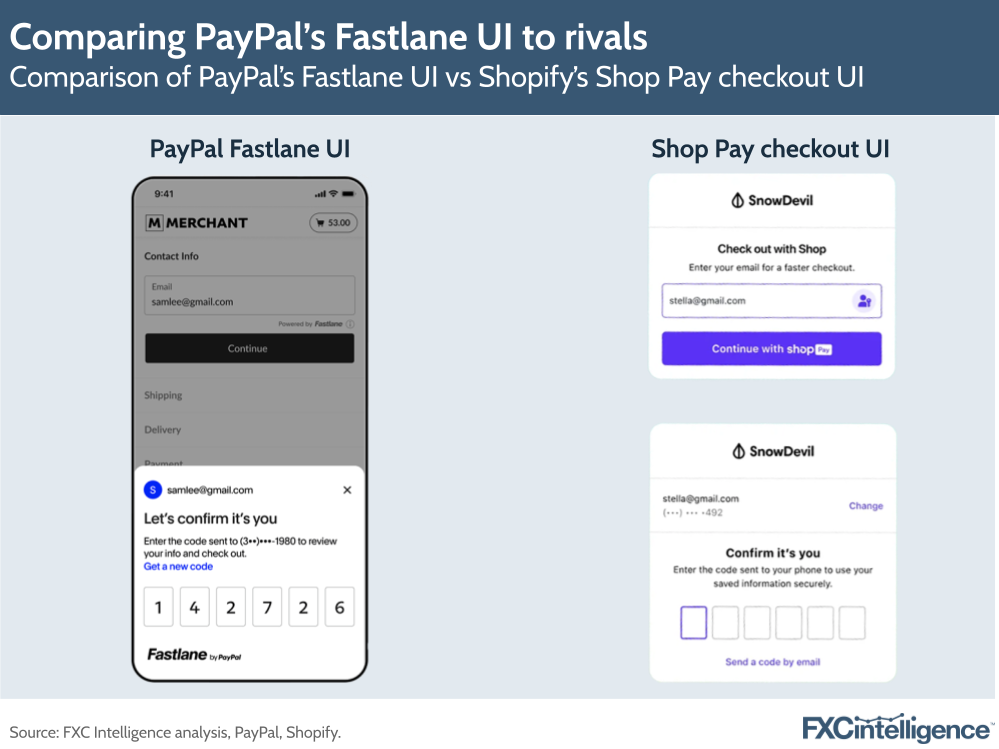
Smart Receipts
Aside from speeding up the checkout process to reduce cart abandonment, another key focus of PayPal’s announcements was encouraging customers to return and make further purchases from merchants. Here, a critical new product is what PayPal is calling Smart Receipts, which represent an advancement on the current receipts every PayPal customer receives whenever they make a purchase.
At present, receipts from PayPal consist of key information regarding individual transactions, including the amount spent, seller, transaction ID and date of purchase, as well as links to manage or dispute the payment. However, with Smart Receipts, PayPal is redesigning this to include additional features for consumers as well as those designed to encourage further shopping.
Under the new design, PayPal customers’ receipts will include a tracking link for their purchase as well as a personalised recommendation from the merchant created using AI and a cashback reward offer.
PayPal argues that because its receipts have a high open rate for the industry – at almost 45% – this represents a strong opportunity for merchants to attract increased customer engagement and purchasing. It also suggests that this use of AI will create greater opportunities for smaller merchants to harness the technology than is currently the case.
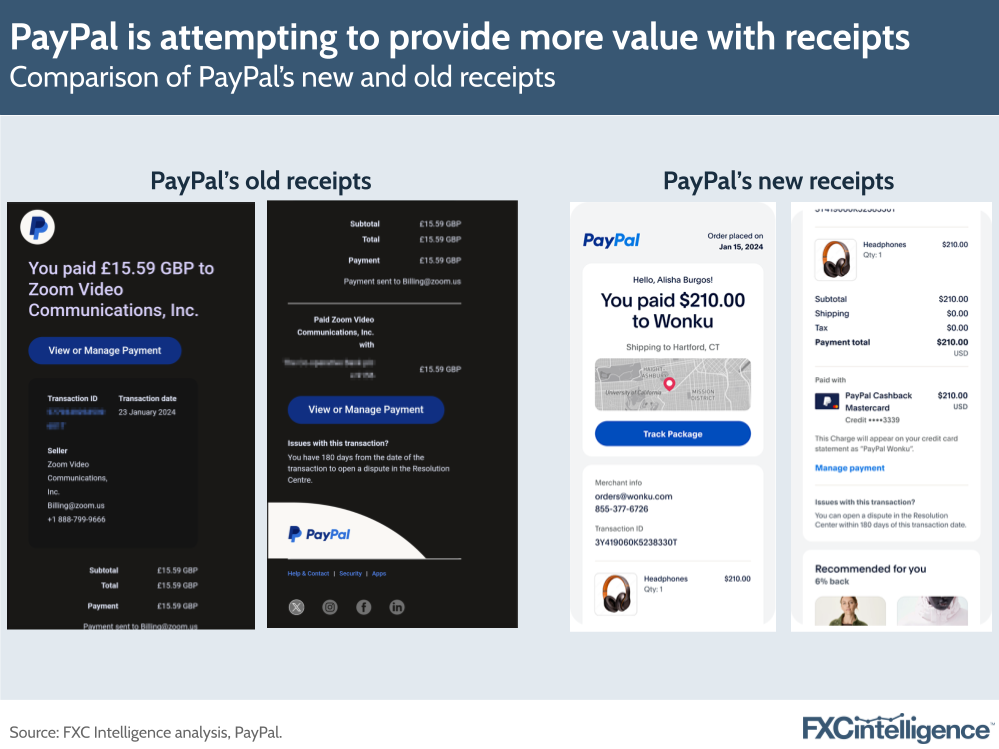
This feature does provide improved opportunities for merchants, but it is not especially novel within the industry. Shop Pay already includes embedded tracking on receipts, while several ecommerce marketplaces include shopping recommendations, with Chinese major Aliexpress using AI-based systems to provide recommendations to its customers. However, the combined offering will be new for some PayPal customers.
Advanced Offers Platform
The recommendation system in PayPal’s receipt is also being reflected in the newly announced Advanced Offers Platform. According to Chriss, this is “giving merchants the ability to reach customers based on what they’ve actually bought across the internet”.
Built on PayPal’s own transaction data, which the company says covers $0.5tn of merchant transactions globally at the “SKU and individual product” level, this is designed to allow merchants to customise offers to individual customers using AI. They will also pay for this on a performance basis, rather than an impression or clicks basis, and the company says it is building a system to allow customers to opt out for privacy.
How significant of a product this will ultimately be remains to be seen. Recommendations are by no means uncommon in ecommerce settings, but the ability to reach potential customers with paid-for, targeted offers at the scale PayPal can provide could be unprecedented.
However, how it is implemented and how effective it is will be critical to its success. Customers will need to feel that what is being offered to them are products they genuinely want, without feeling like the system knows too much about them.
CashPass
This offer system will also feed into an updated version of the PayPal app, which will introduce a cash back offer system for customers. Dubbed CashPass, this is designed to provide cash back offers from different merchants that have been personalised using AI, which can be stacked from rewards from existing products, notably the PayPal Savings account or the PayPal Cashback Mastercard.
Notably, PayPal has only confirmed a US launch of CashPass, which is set to launch with a limited range of high-profile brands, including eBay, Uber, Best Buy, Walmart, McDonald’s and Ticketmaster, in March 2024.
The cash back offering is slightly reminiscent of Aliexpress’s coupon-based system of incentives, however it remains one of the most novel offerings announced at the PayPal First Look keynote.
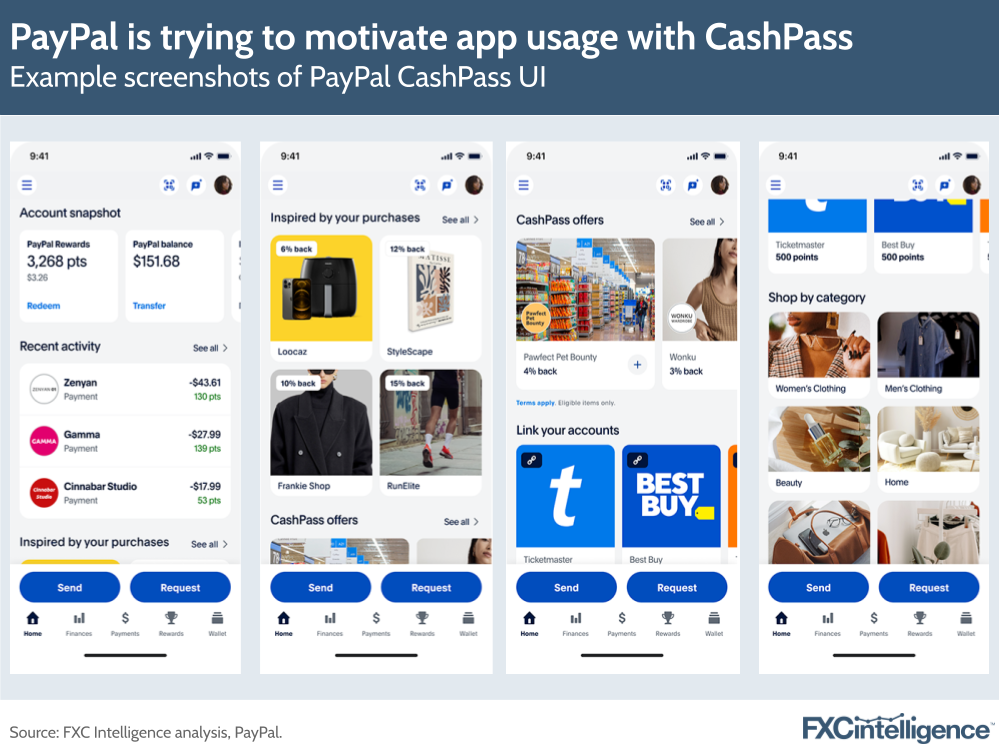
Venmo Business Profiles
Finally, the sixth element of PayPal’s First Look announcement also ties into the company’s cash back initiative through the evolution of Venmo Business Profiles. First launched in 2021, these are designed to bring a social element to the platform for small businesses that already use Venmo to accept payments by enabling customers to subscribe to businesses as followers.
Under the new system, businesses will be able to offer promotions to their subscribers, paying a fee when customers redeem the offer, in a format that appears to follow a similar structure to PayPal’s Advanced Offers Platform.
Businesses will also receive badges for being in the top 50%, 30%, 15% or 1% for their area, which will be visible when they run promotions and when customers share a purchase on Venmo. They will also be able to track improvements to reach and revenue under the system.
As Venmo is only available in the US, it is unlikely that this feature will be available beyond the country.
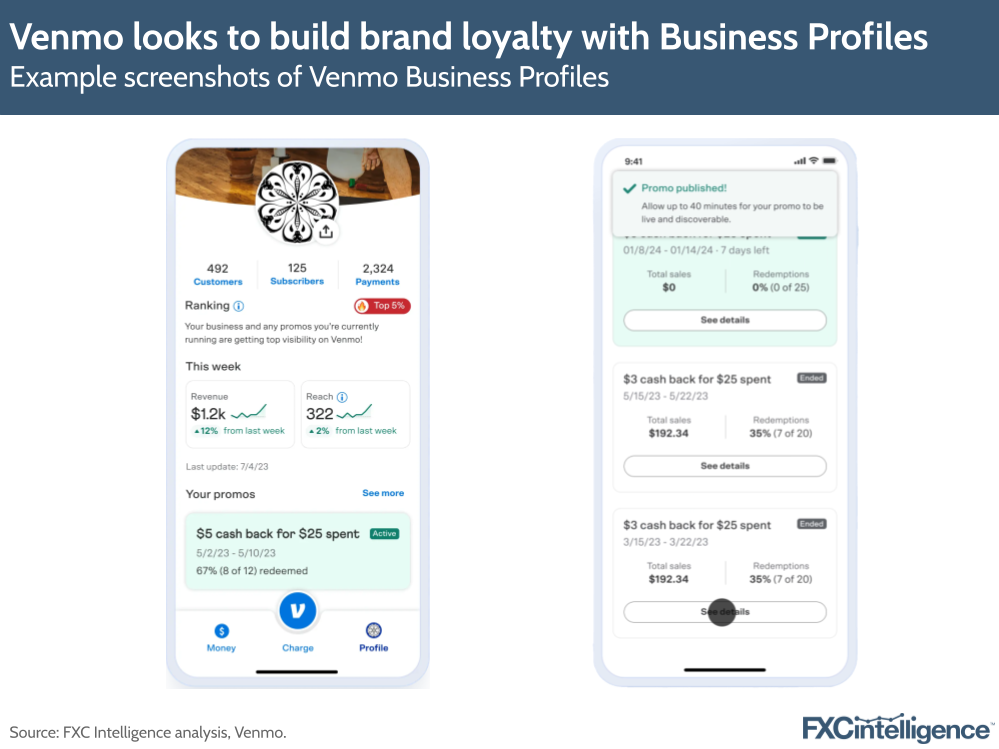
AI in PayPal’s strategy announcements
AI was framed as central to PayPal’s First Look announcement both ahead of the event and in the keynote address.
In a widely quoted interview with CNBC’s Squawk on the Street ahead of the announcement, CEO Alex Chriss said that the company had “the ability to leverage AI to deliver incredible improvements” for its merchants’ conversion rates. In the keynote itself, AI was framed as key from the outset, with Chriss characterising the current period as “the age of AI”.
Notably, AI was one of the most frequently mentioned topics in the keynote, earning nine mentions across the 17.5-minute video.
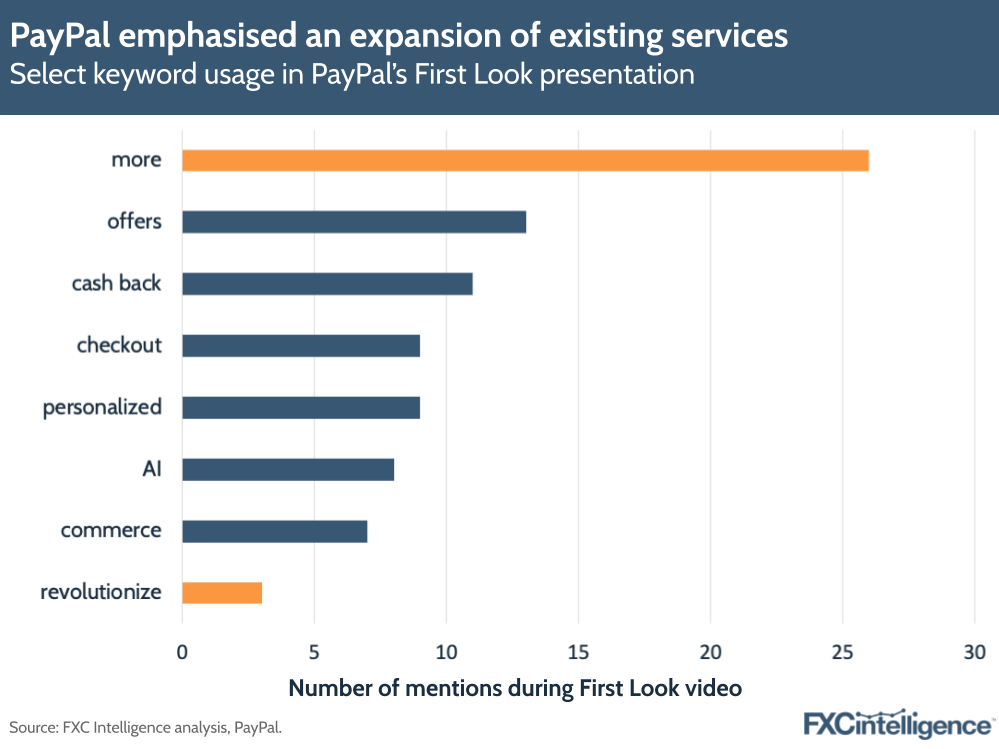
However, while AI was mentioned frequently, it was only directly mentioned in two out of the four products focused on during the talk, and discussion of how the technology would be deployed remained extremely light. There was also no discussion of any specific AI technologies or providers, providing little insight into the precise details of the technology’s intended use.
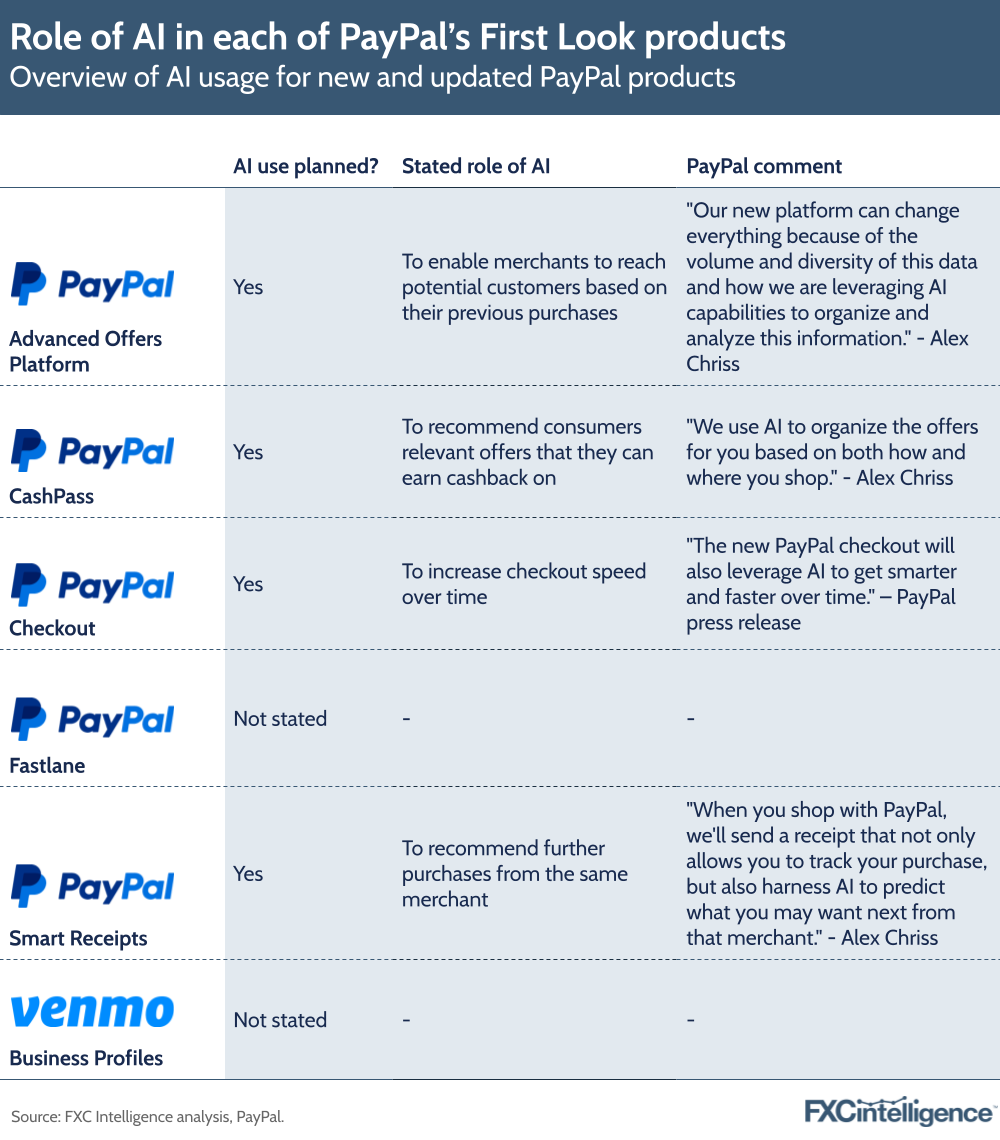
Expectations and industry reaction
Described by Chriss as an innovation event, the AI-led First Look keynote had been hoped to provide a critical insight into the new CEO’s plans to turnaround PayPal. While never reaching a financial state that could be genuinely described as poor, the company had begun to see top-line revenue growth that was considerably more sluggish than in previous years, particularly compared to the peaks of the pandemic.
Perhaps more concerningly, the company had also seen three consecutive quarters of drops in active account numbers, a first for PayPal, although it has previously said that this was the result of efforts to “flush out low-quality customers”. Nevertheless, the event was hoped to provide signs of a path to turn this around and return the company to stronger levels of growth.
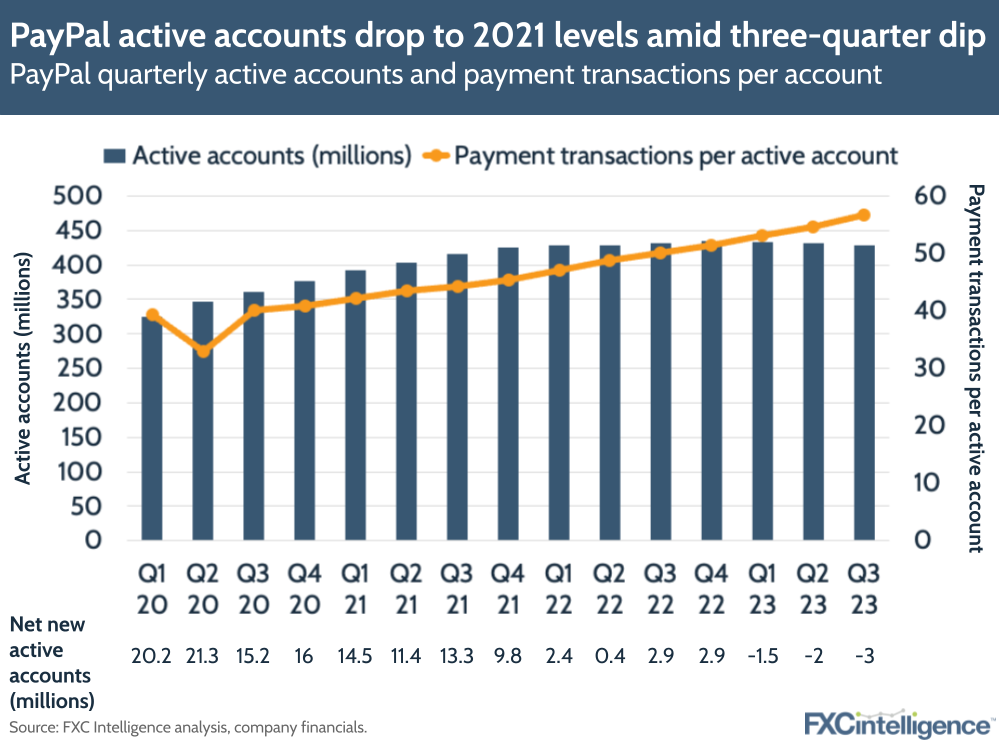
However, the industry reaction to the First Look keynote has not been what PayPal would have hoped. While the company’s share prices rose sharply following Criss’s comments during the CNBC interview, they dropped just as sharply following the release of the keynote video. They recovered to pre-interview numbers in the days since, but have since dropped again following the announcement of the layoffs.
This negative response is largely the result of a perceived disconnect between the expectations generated by the CNBC interview and the reality presented in the keynote. Many felt that the products announced were not notably innovative, but instead represented PayPal catching up to other players in the industry.
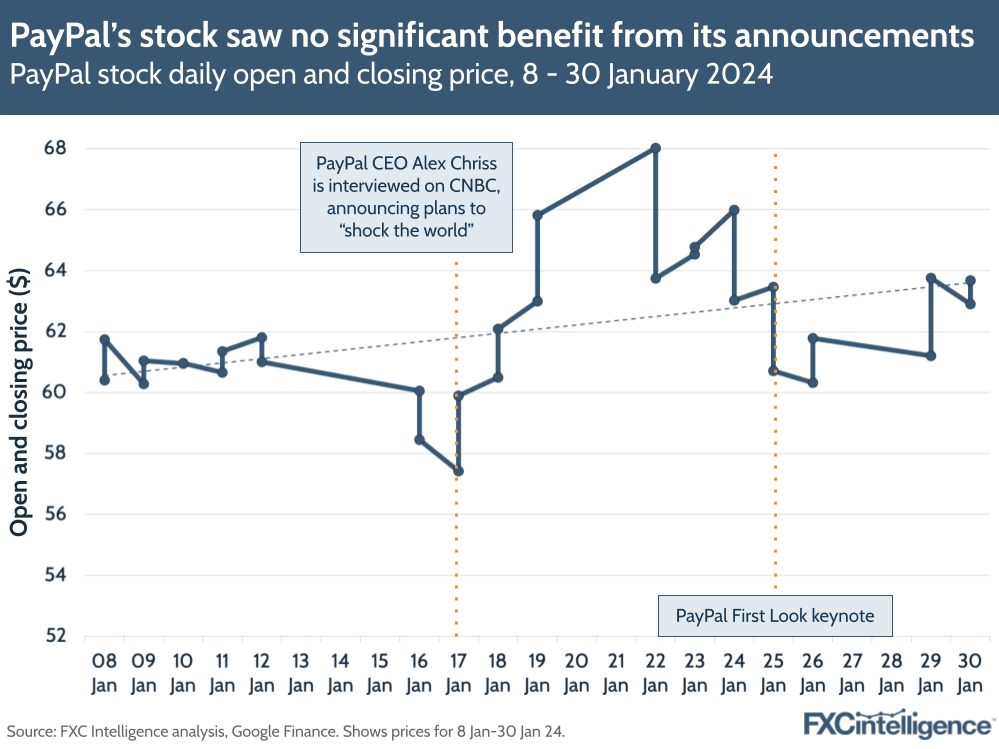
What was missing: P2P, stablecoins and beyond
Crucially, while this was framed as the company’s leading innovations, the announcement focused on a relatively narrow band of PayPal’s products and reach. Firstly, it was an announcement solely focused on the US market. While Chriss did indicate that there were plans to roll out some of the services internationally eventually, no clear timeframe was provided for this and at least one of the products is for a service only offered in the US.
However, beyond this there was no mention at all of PayPal’s P2P payments offerings, either through its main account-to-account service or its remittance product offered via brand Xoom. In the case of the latter, it remains possible that the company is looking to sell the brand, following reports last year of a potential plan to offload the remittance player.
Notably, there was no mention of any cross-border retail, despite this representing a significant area of PayPal’s commerce offering. Cross-border payments represented 12% of PayPal’s total payment volume as of Q3 2023, equivalent to $46.5bn in the quarter.
There was also no mention of stablecoins or cryptocurrency, despite the fact that PayPal announced the launch of its own US dollar-backed stablecoin PYUSD in August 2023 and many commentators had expected stablecoins to form part of the strategy announced at this First Look event. This is unlikely to be a sign that PayPal is abandoning its stablecoin, particularly as PayPal Ventures used PYUSD to invest in crypto embedded finance startup Mesh earlier this week, but it does suggest the digital currency will not be central to the company’s core strategy this year.
Also absent were other key PayPal brands, including enterprise-focused Braintree, despite being a key contributor to the company’s growth rates in Q3 2023.
How significant these absences are remains to be seen. This announcement may have been intended to be one of several, rather than an overall strategy. International markets, where the company has been seeing stronger recent growth, as well as other product areas, may be set for discussion in earnings calls or other releases later in the year.
Alternatively, this may genuinely be indicative of the focus that Chriss plans to have during his tenure at PayPal, with a more AI and technology-focused approach to its core ecommerce business and less of a focus on P2P payments. With a less-than-ideal market reaction, Chriss is likely to look to reassure investors at the company’s Q4 2024 earnings call, which is scheduled for 7 February, and we can expect some indication of the company’s wider priorities going forward. The focus of the layoffs may also provide a further sense of this.
Nevertheless, regardless of PayPal’s priorities, the announcements made as part of the First Look strategy should not be dismissed. While lacking the headline-grabbing appeal and promised shock value, they do have the potential to provide vital improvements to a brand that has been lacking innovation for some years. How much this will translate into improvements to its financial performance, however, remains to be seen.



